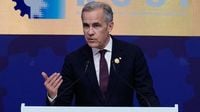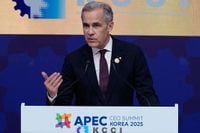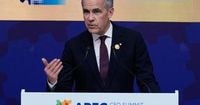On October 31, 2025, in the historic city of Gyeongju, South Korea, a meeting took place that could reshape the trajectory of China-Canada relations for years to come. Chinese President Xi Jinping and Canadian Prime Minister Mark Carney sat down together during an Asia-Pacific summit, signaling a rare moment of optimism after years of diplomatic frost. According to multiple reports, both leaders described the encounter as a “turning point” in their countries’ long-fractured relationship.
The significance of this meeting wasn’t lost on either side. In a statement released by Canadian officials and echoed in Chinese state media, Xi Jinping remarked that the relationship was "showing signs of recovery, thanks to the joint efforts of both sides." He went further, expressing China’s readiness to "work together with Canada to take this meeting as an opportunity to promote the return of bilateral relations to a healthy, stable, and sustainable track as soon as possible." Mark Carney, who took office as prime minister in March 2025, responded in kind, accepting an invitation from Xi to visit China—a symbolic gesture of goodwill, though no date has yet been set.
Carney, speaking to reporters after the meeting, didn’t hide his satisfaction. "We now have a turning point in the relationship, a turning point that creates opportunities for Canadian families, for Canadian businesses and Canadian workers, and also creates a path to address current issues," he said. His words echoed a palpable sense of relief and hope for a new chapter in a relationship battered by years of tension and trade disputes.
To understand the weight of this moment, it’s worth recalling how things soured in the first place. The diplomatic chill began in late 2018, when Canadian authorities arrested Meng Wenzhou, a senior executive at Chinese tech giant Huawei, as part of an extradition request from the United States. In swift retaliation, China detained two Canadians, Michael Kovrig and Michael Spavor, on espionage charges. The standoff dragged on for nearly three years, with no real thaw even after all three were released in 2021. The damage, it seemed, would take more than time to heal.
But the troubles didn’t end there. In 2024, Canada imposed a sweeping 100% tariff on electric vehicles (EVs) imported from China, along with a 25% tariff on Chinese steel and aluminum. According to Associated Press and other outlets, this move—made in tandem with similar U.S. actions—sparked a new round of tit-for-tat tariffs. China responded by slapping hefty import taxes on Canadian canola, seafood, and pork, squeezing Canadian exporters and further straining ties. The back-and-forth left both economies bruised and diplomatic channels clogged with grievances.
During their meeting in South Korea, Xi and Carney tackled these trade irritants head-on. Both leaders directed their officials to move quickly to resolve outstanding issues, with particular attention to the tariffs on EVs, canola, and seafood. China, for its part, offered to remove import taxes on some Canadian products if Ottawa agreed to drop its 100% EV tariff. The Canadian statement described the talks as pragmatic and constructive, with Xi calling for expanded cooperation in "economy, trade, and energy."
The ripple effects of these disputes extend far beyond the two countries. Both Canada and China have been caught in the crossfire of tariffs imposed by U.S. President Donald Trump, whose protectionist policies have upended global supply chains and forced traditional allies to reconsider their trade strategies. Canadian canola producers, seafood exporters, and pork farmers have all faced steep Chinese tariffs in retaliation for Ottawa’s stance on Chinese EVs and related goods. Meanwhile, Trump has signaled plans to raise tariffs on Canadian imports by another 10%, just as the Canada-U.S. free trade agreement comes up for review.
For Prime Minister Carney, the stakes are especially high. He has made it a priority to double Canada’s non-U.S. exports over the next decade, aiming to reduce the country’s dependence on its southern neighbor and open new markets in Asia and beyond. The rapprochement with China, though fraught with political risk, could be a crucial step in that direction. But it’s not without controversy: as Daniel Béland, a political science professor at McGill University, noted, "The Trump administration is very likely to resent this rapprochement between Canada and China, but the White House’s protectionist policies are at least partly to blame for it, something U.S. officials should know."
Indeed, the possibility of Canada removing its EV tariffs—and thereby allowing more affordable Chinese electric vehicles into the Canadian market—has already raised eyebrows in Washington. "Removing EV tariffs on China and allowing for the sale of Chinese EV vehicles would probably infuriate the Trump White House," Béland observed, "but moving in that direction would also send a strong message about the rapprochement between Canada and China while making more affordable EV cars accessible to Canadian consumers." It’s a delicate balancing act: pursue economic opportunity and diversification, or risk the wrath of a powerful ally.
China’s ambassador in Ottawa recently made it clear that Beijing’s levies would be dropped if Canada cancels its EV tariffs, a move that could provide immediate relief to struggling Canadian exporters. At the same time, both countries are feeling the pinch from Trump’s tariffs, making cooperation not just desirable but necessary. The leaders’ decision to focus on practical solutions—rather than grand gestures—reflects a mutual recognition that the old ways of doing business no longer suffice in a world of shifting alliances and economic uncertainty.
Of course, skepticism remains. Years of mistrust and retaliatory measures have left deep scars, and not everyone is convinced that a single meeting can erase the past. But for now, at least, there’s a sense that something has changed. As Xi put it, "We are willing to work together with Canada to take this meeting as an opportunity to promote the return of bilateral relations to a healthy, stable, and sustainable track as soon as possible." Whether that promise holds will depend on the actions both countries take in the coming months.
For Canadian families, businesses, and workers—and for their Chinese counterparts—the hope is that this diplomatic thaw will translate into real economic opportunity and renewed trust. The world will be watching closely as the two nations navigate the challenges ahead, seeking not just to patch up old wounds but to build something more resilient for the future.






